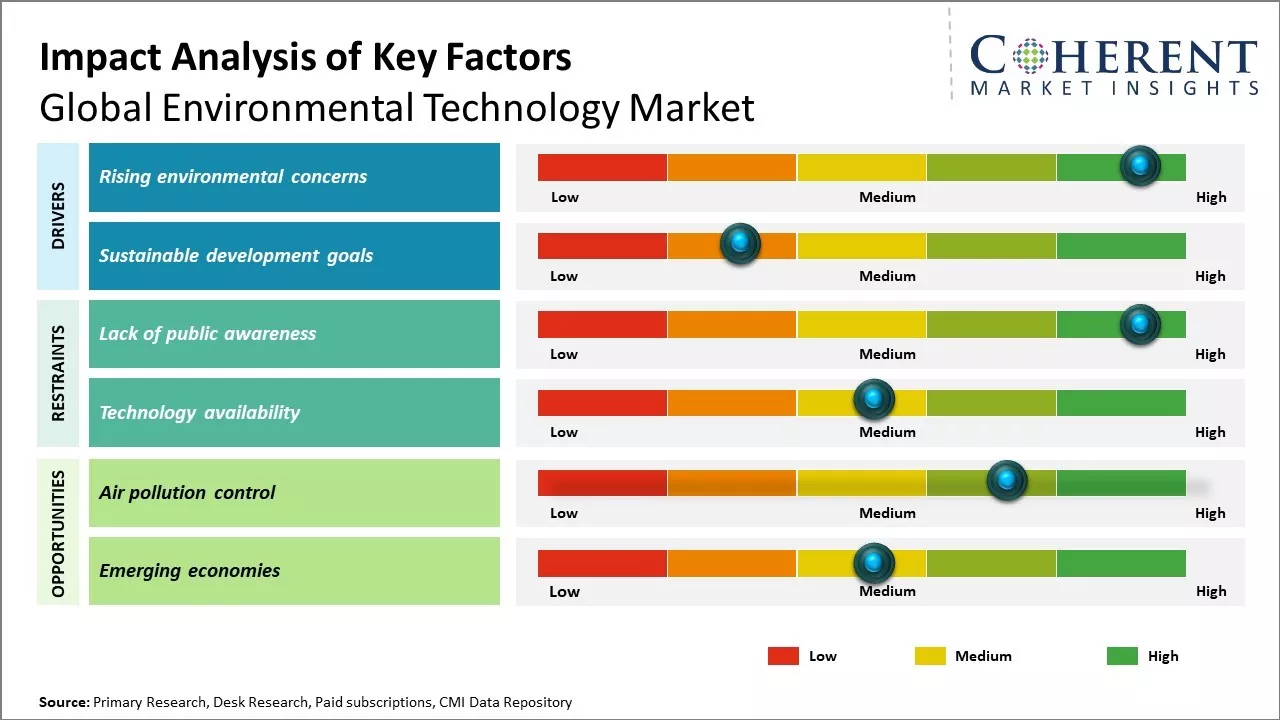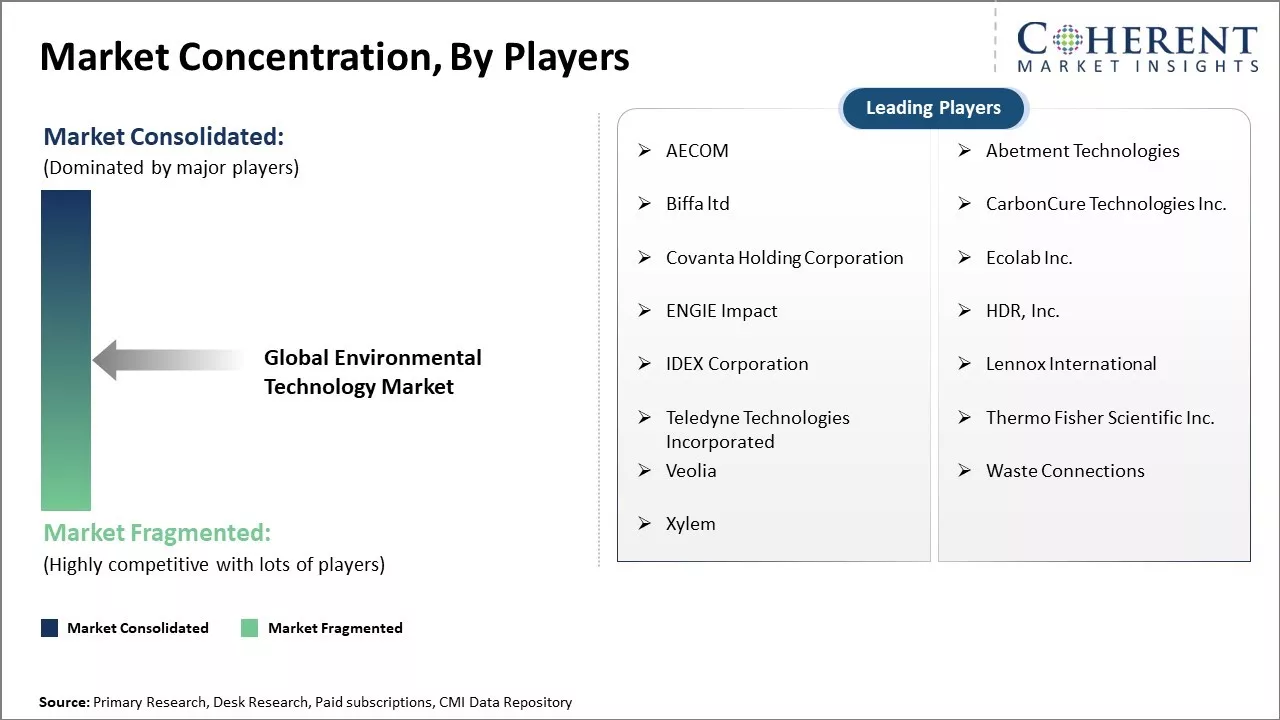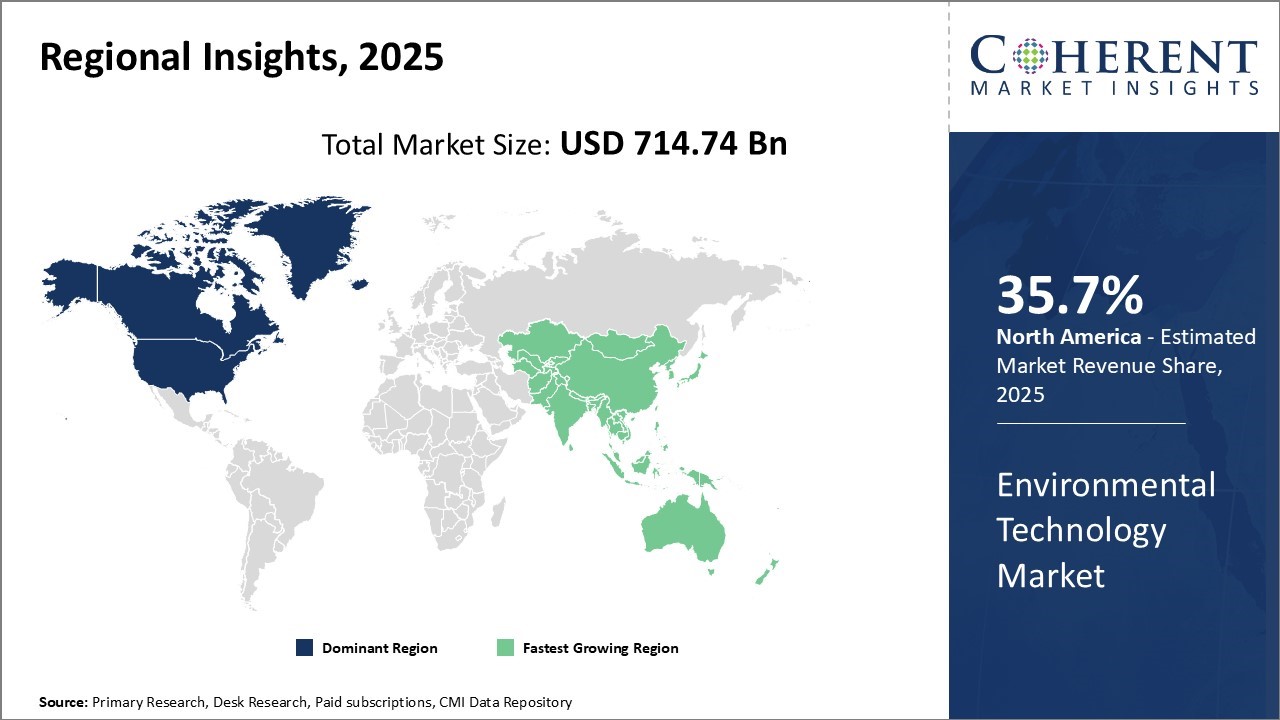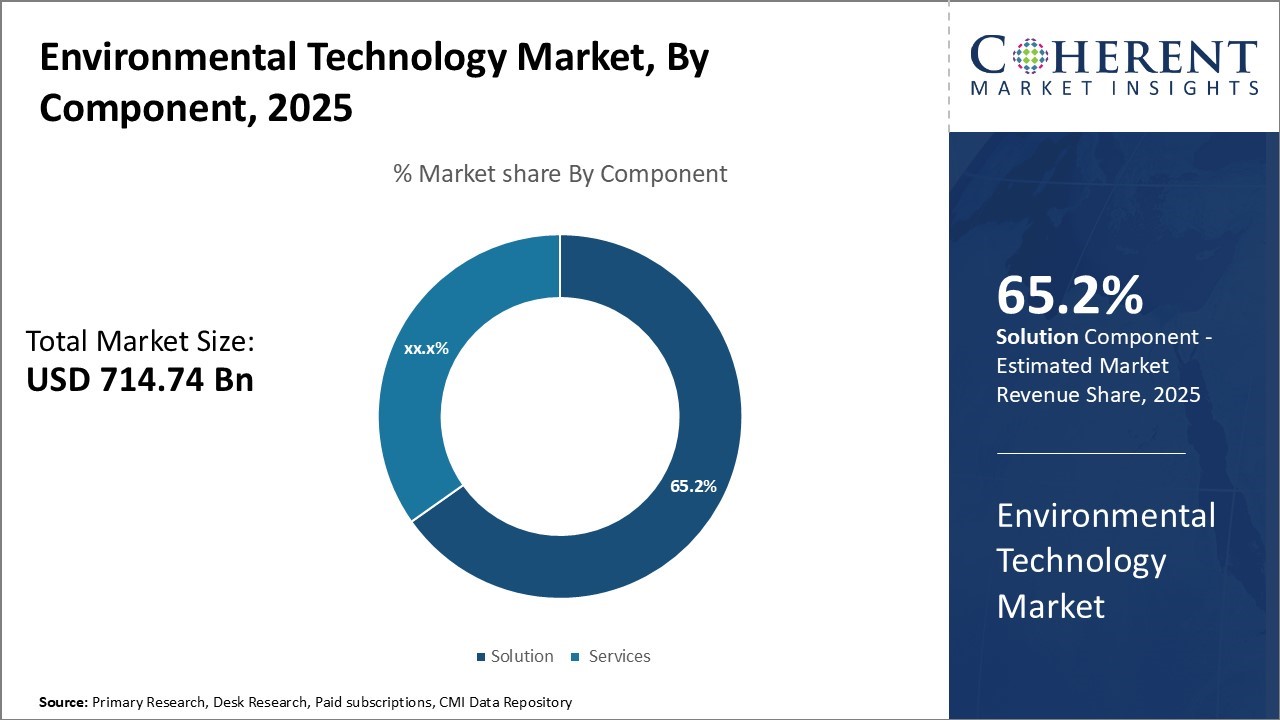Environmental Technology Market Analysis & Forecast- 2025-2032
Global Environmental Technology Market size is estimated to be valued at USD 714.74 Bn in 2025 and is expected to reach USD 1,054.29 Bn by 2032, exhibiting a compound annual growth rate (CAGR) of 5.7% from 2025 to 2032.

To learn more about this report, Download Free Sample
Key Takeaways
- By Component, the Solution segment is expected to lead the environmental technology market outlook with a projected 65.2% share in 2025, driven by its scalability, ease of deployment, and suitability for various environmental monitoring and compliance applications.
- By Application, the Wastewater Treatment segment is anticipated to hold the largest share of 34.8% in 2025, owing to growing global concerns over water scarcity and stringent regulations on industrial and municipal effluent discharge.
- By End User, the Energy & Utilities segment is projected to dominate the market with a 39.2% share in 2025, supported by rising investments in clean energy infrastructure and increasing adoption of environmental monitoring solutions for regulatory compliance.
- By Region, North America is expected to maintain its lead in the environmental technology market with a projected 35.7% share in 2025, fueled by strong regulatory frameworks, advanced R&D capabilities, and rising sustainability initiatives.
Market Overview
Rising awareness regarding environmental pollution and depletion of natural resources can boost demand for advanced environmental protection technologies. Furthermore, stringent government regulations regarding carbon emissions and wastewater discharges have encouraged adoption of technologies like carbon capture and storage, green building, and water purification. Growing industrialization and urbanization in emerging economies also contribute to rising pollution levels, thus, boosting investments in innovative solutions and services. However, high initial investments required for deployment of these technologies can hamper the market growth.
Current Events and Its Impact on the Global Environmental Technology Market
|
Event |
Description and Impact |
|
Regulatory Mechanisms: EU Carbon Border Adjustment Mechanism (CBAM) |
|
|
Regional Initiatives: China’s Beautiful China 2025 |
|
|
Technological Advancements: Green Hydrogen Expansion |
|
Uncover macros and micros vetted on 75+ parameters: Get instant access to report
Microeconomic and Macroeconomic factors impact growth – Environmental Technology Market
Microeconomic Factors Affecting Growth
These are factors that influence the market at the firm or industry level
Consumer Demand & Preferences
- Increasing environmental awareness among consumers drives demand for clean tech, green products, and sustainable services.
- Willingness to pay a premium for eco-friendly solutions is growing but varies by region and income level.
Input Costs & Availability
- High R&D and raw material costs can limit scalability of certain technologies (e.g. rare earth metals in EVs or solar panels).
- Some technologies rely on scarce or geopolitically sensitive materials.
Technology Innovation & Adoption
- Firms that innovate faster (e.g., improving efficiency in solar panels or batteries) gain competitive advantage.
- Market adoption depends on performance, cost-parity with conventional tech, and ease of integration.
Competition and Market Structure
- Increasing competition among clean tech firms can spur innovation but compress margins.
- Consolidation or dominance by large incumbents (e.g., in energy or utilities) may slow adoption of disruptive technologies.
Macroeconomic Factors Affecting Growth
Government Policies and Regulations
- Environmental laws, emissions targets, and carbon pricing mechanisms directly shape demand.
- Policies like net-zero targets, pollution control standards, and green building codes stimulate demand for environmental technologies.
Public and Private Investment
- Global trends in green finance, ESG investing, and climate funds (e.g., EU Green Deal, U.S. Inflation Reduction Act) fuel capital inflows into environmental tech.
- Public-private partnerships are growing in areas like water infrastructure and renewable energy.
Economic Growth / GDP
- Strong economic growth generally supports investment in new technologies.
- However, in downturns, spending on environmental upgrades may be deprioritized unless mandated or incentivized.
Interest Rates and Inflation
- High interest rates make capital-intensive environmental projects (like wind farms or carbon capture facilities) less attractive.
- Inflation raises the cost of materials and technology deployment, impacting project viability.
Market Concentration and Competitive Landscape

To learn more about this report, Download Free Sample
Market Opportunities- Air pollution control
Air pollution control can offer growth opportunity for global environmental technology market. Rapid urbanization and industrialization have led to alarming air pollution levels in many parts of the world.
According to the World Health Organization, around 7 million deaths globally are attributed to air pollution every year. More than 90% of people worldwide breathe polluted air, placing them at higher risks of respiratory and cardiovascular diseases. Several metropolitan cities now face air quality issues that mandate immediate remedial action.
Stricter emission norms by governments and growing health concerns have pushed innovations in air treatment products. Manufacturers are developing advanced technologies for ambient as well as source pollution monitoring and control. Various desulfurization and denitrification techniques find widespread usage in treating industrial emissions.
Solutions such as diesel particulate filters, selective catalytic reduction systems witness huge adoption in vehicles. Governments across regions offer attractive subsidies for switching to electric mobility further, that curb the vehicular pollution.
Rising environmental concerns
As climate change and pollution become areas of higher concern, they are receiving attention for their potential impact on public health, nature, and future sustainability. It's becoming more difficult to ignore the reality of air and water pollution, waste management, greenhouse gas emissions, depleting natural resources, and losing biodiversity. Public awareness campaigns focusing on "greener" practices are being embraced by governments, businesses, and people alike. The emergence of these campaigns drove change in policies with the introduction of stricter emission regulations alongside recycling requirements as well as tax benefits aimed for renewable energy investments.
There is also an increase in demand for environmentally friendly products and services by businesses. The resulting combination nurtures cross-sector innovation while created heightened competition . Industries are already implementing advanced technologies that enable them to monitor their efficiency and waste reduction as well as pollutant treatment alternatives. As sustainable solutions gain popularity from society and industries due to their cost-saving opportunities, it supports firms specializing in green technologies such as clean energies, green building design, pollution control systems, wastewater treatment plants or recycling stations.
Sustainable development goals
In 2015, all member states of the United Nations ratified the Agenda for Sustainable Development by 2030 which contains 17 primary SDGs set to focus global development and encourage action over a period of 15 years. Some of the goals relate directly to important environmental challenges and call for rigorous climate action; clean water and sanitation, affordable energy, sustainable urbanization and community development, reduced consumption and production waste alongside life below water. Meeting these environmental objectives will require bold new approaches, including innovative technologies.
To further pursue these goals and targets outlined in the agenda, Governments are actively pursuing plans that include providing initiatives, incentives, investment funding along with launching multi-purpose programs. Corporate organizations also understand the benefit of aligning their operations with sustainability as it comes with an economic advantage along with improvements to their public image. The adoption of cleantech solutions implemented due to the 2030 SDGs is resulting in the pivoted focus on improving them. With respect to the goals laid out in the SDGs, major advancements need to be made in technologies such as renewable energy sources like electric vehicles and green buildings as well as increasing resource efficiency while reducing waste recycling-and conserving biodiversity if we are to achieve economically sound growth- which integrates environmental factors into decision-making processes.
Environmental Technologies Market Insights, By Component
In terms of component, solution segment is estimated to contribute the highest market share of 65.2% in 2025, owing to increasing investments made by both public and private organizations towards developing innovative green technologies.
Solution segment includes various environment-focused technological products and systems that help monitor, reduce and treat various forms of pollution. Major solution offerings include air pollution control technologies, eco-friendly industrial equipment, wastewater treatment systems, sustainable energy products and renewable energy power generation solutions among others.
There has been rising focus on addressing various environmental issues through technological interventions in the recent past few years. Both governments and private businesses are allocating more funds towards research and development of advanced green technologies.
Various solution developers are also introducing new and improved versions of existing environmental solutions to gain more customers. For example, air pollution control system manufacturers are launching solutions that can capture more pollutants at lower costs. Renewable energy product brands are focusing on capacity expansion and performance enhancement of their offerings.
Large scale deployment of solution products can drive the segment growth. For example, wastewater treatment plants equipped with advanced systems are being set up across cities and industrial areas to manage the growing volumes of effluents. Renewable energy power plants based on solar, wind, hydro and other clean sources are increasingly being installed to reduce dependence on conventional fuels. Governments in both developed and developing nations are implementing stricter emission control norms that boosts adoption of eco-friendly industrial machinery and pollution monitoring devices by companies.
Environmental Technologies Market Insights, By Application
In terms of application, wastewater treatment segment is estimated to contribute the highest market share of 34.8% in 2025, owing to stringent wastewater discharge norms enforced by environmental agencies worldwide. Wastewater consists of used water generated from industrial operations, commercial establishments and households after daily use. If not treated properly, wastewater discharged into water bodies can pollute sources and ecosystems severely.
Regulatory authorities have continuously tightened permissible limits on pollutant levels in wastewater that can be let out into the environment post treatment. Non-compliance to stringent rules can attract heavy penalties for offenders. This has compelled a wide range of wastewater generating entities like manufacturing plants, food processing units, power facilities, real estate complexes and municipalities to invest considerably in advanced treatment systems and technologies.
Organizations are automating their treatment facilities, adopting membrane bioreactor systems, advanced oxidation processes and other high-end techniques to deeply cleanse wastewater before disposal.
Rising volumes of wastewater due to rapid industrialization and urbanization as well as increased public awareness about sanitation has boosted need for robust treatment solutions across the world. Municipal bodies are extensively spending on developing centralized sewage treatment infrastructure to manage the growing quantities of urban sewage. Rising need to eliminate pollution from industrial and domestic wastewater streams through effective treatments to can drive the segment growth.
Environmental Technologies Market Insights, By End User
In terms of end user, energy & utilities segment is estimated to contribute the highest market share of 39.2% in 2025, due to the ongoing transition occurring in the energy sector towards adopting cleaner and sustainable power sources. The energy and utilities industry has traditionally relied heavily on fossil fuels like coal and natural gas for power generation. However, mounting concerns about climate change along with depleting reserves of conventional fuels have ignited a large-scale shift towards renewable alternatives in recent times.
Transitioning to renewable power sources has become a top priority for utilities and energy companies worldwide. Massive investments are being made into setting up utility-scale solar, wind and hydropower projects. Technologies supporting clean fuels like stringent carbon emission norms especially in European nations have further boosted clean energy investments.
Integration of green solutions specific to sectors like smart grid, e-mobility, and green hydrogen is also rising. Rising demand to decarbonize energy systems along with supportive policies can drive the segment growth.
Regional Insights

To learn more about this report, Download Free Sample
North America Environmental Technology Market Analysis and Trends
North America is poised to dominate the global environmental technology market with an estimated 35.7% share in 2025, driven by strong regulatory frameworks mandating emission control and pollution mitigation standards. The U.S. market benefits from robust governmental support and the presence of leading environmental technology firms headquartered in innovation hubs like Chicago, San Francisco, and New York.
These cities foster R&D and commercialization, further supported by top-tier research universities and consistent funding for green initiatives. Strong intellectual property protections have encouraged domestic companies to invest in advanced solutions across renewable energy, green infrastructure, pollution management, and resource recycling, cementing North America’s leadership in the sector.
Asia Pacific Environmental Technology Market Analysis and Trends
Asia Pacific represents the fastest growing environmental technology market, fueled by rapid urbanization and industrialization across countries such as China, India, and Vietnam. This growth has intensified the need for efficient waste management, clean energy, and pollution control solutions.
Regional governments are rolling out supportive green policies such as China’s 2060 carbon neutrality pledge and strategic investments in solar power under its 13th Five-Year Plan that are accelerating infrastructure development. Global environmental technology firms are increasingly establishing operations in the region to meet surging demand. A large consumer base, cost-effective skilled labor, and expanding urban centers make Asia Pacific a highly attractive market for future growth and innovation.
Dominating Countries in the Environmental Technology Market
United States Environmental Technology Market Analysis and Trends
The United States leads the global environmental technology market, bolstered by a mature industrial base, comprehensive environmental regulations, and a strong innovation ecosystem. Cities like San Francisco, Chicago, and New York serve as hubs for environmental R&D, home to key industry players and research institutions. Federal and state-level policies continue to promote emission control, renewable energy adoption, and pollution mitigation technologies. U.S.-based companies are at the forefront of developing scalable.
Market Report Scope
Environmental Technology Market Report Coverage
| Report Coverage | Details | ||
|---|---|---|---|
| Base Year: | 2024 | Market Size in 2025: | USD 714.74 Bn |
| Historical Data for: | 2020 To 2024 | Forecast Period: | 2025 To 2032 |
| Forecast Period 2025 to 2032 CAGR: | 5.7% | 2032 Value Projection: | USD 1,054.29 Bn |
| Geographies covered: |
|
||
| Segments covered: |
|
||
| Companies covered: |
AECOM, Abetment Technologies, Biffa ltd, CarbonCure Technologies Inc., Covanta Holding Corporation, Ecolab Inc., ENGIE Impact, HDR, Inc., IDEX Corporation, Lennox International, Teledyne Technologies Incorporated, Thermo Fisher Scientific Inc., Veolia, Waste Connections, Xylem |
||
| Growth Drivers: |
|
||
| Restraints & Challenges: |
|
||
Uncover macros and micros vetted on 75+ parameters: Get instant access to report
Analyst Viewpoint
- The environmental technology market is gaining strong traction globally, driven by stricter regulations and net-zero commitments from governments across major economies.
- Escalating climate risks and extreme weather events are pushing businesses to adopt sustainable solutions like pollution control, renewable energy, and waste management technologies.
- High initial investment costs and fragmented regulatory landscapes remain key challenges, particularly in cross-border deployment of environmental technologies.
- The shortage of skilled professionals in environmental engineering and green technology R&D is slowing implementation and innovation in certain regions.
- Promising growth areas include carbon capture and storage (CCS), smart waste management, and advanced water treatment systems, supported by rising funding and public-private partnerships.
- Digital innovations, such as IoT-based monitoring and AI-driven analytics, are opening new revenue streams and reshaping the environmental tech landscape.
- North America leads the global market, backed by robust policy support and large-scale investments in clean technology infrastructure.
- Asia-Pacific is emerging as the fastest-growing region, driven by industrial growth, urbanization, and rising environmental awareness in China, India, and Southeast Asia.
Global Environmental Technology Market: Key Developments
- In May 2025, Climeworks and Microsoft expanded their direct air capture partnership, aiming to remove 1 million tons of CO₂ annually by 2030 through advanced carbon capture systems.
- In January 2025, Intercontinental Exchange, Inc. announced plans to launch an environmental registry technology service to bring best-in-class infrastructure to registries and registry users, and to support the adoption of carbon credits as an asset class.
Market Segmentation
- Component Insights (Revenue, USD Bn, 2020 - 2032)
- Solution
- Services
- Water Services
- Waste Management Services
- Energy Services
- Industrial Services
- Application Insights (Revenue, USD Bn, 2020 - 2032)
- Power Generation & Fuel
- Solid Waste Treatment
- Pollution Monitoring
- Wastewater Treatment
- Water Purification Management
- Sewage Treatment
- Precision Cooling
- Gas Dissolution
- Others
- End User Insights (Revenue, USD Bn, 2020 - 2032)
- Residential/Municipal
- Industrial
- Energy & Utilities
- Transportation & Logistics
- Oil & gas
- Food & Beverages
- Construction & Building Materials
- Retail & Consumer goods
- Government
- Others
- Regional Insights (Revenue, USD Bn, 2020 - 2032)
- North America
- U.S.
- Canada
- Latin America
- Brazil
- Argentina
- Mexico
- Rest of Latin America
- Europe
- Germany
- U.K.
- France
- Russia
- Rest of Europe
- Asia Pacific
- China
- India
- Japan
- Australia
- South Korea
- ASEAN
- Rest of Asia Pacific
- Middle East & Africa
- GCC Countries
- South Africa
- Rest of Middle East & Africa
- Key Players Insights
- AECOM
- Abetment Technologies
- Biffa ltd
- CarbonCure Technologies Inc.
- Covanta Holding Corporation
- Ecolab Inc.
- ENGIE Impact
- HDR, Inc.
- IDEX Corporation
- Lennox International
- Teledyne Technologies Incorporated
- Thermo Fisher Scientific Inc.
- Veolia
- Waste Connections
- Xylem
Sources
Primary Research Interviews
- Environmental technology solution providers and manufacturers
- Government environmental agencies and regulatory officials
- Industrial end-users and facility managers
- Environmental consultants and engineering firms
- Others
Databases
- Environmental Protection Agency (EPA) databases
- International Energy Agency (IEA) database
- World Bank Environmental Data
- OECD Environmental Statistics
- Others
Magazines
- Environmental Technology Magazine
- Pollution Engineering Magazine
- Water & Wastewater International
- Environmental Science & Technology
- Others
Journals
- Journal of Environmental Technology
- Environmental Science & Policy
- Journal of Cleaner Production
- Others
Newspapers
- Environmental Finance
- GreenBiz Daily
- Environmental Leader
- Climate Change News
- Others
Associations
- Environmental Technology Council (ETC)
- International Association of Environmental Technology
- Water Environment Federation (WEF)
- Air & Waste Management Association (AWMA)
- Others
Public Domain Sources
- United Nations Environment Programme (UNEP) reports
- Government environmental department publications
- International environmental treaties and agreements
- Public environmental impact assessments
- Others
Proprietary Elements
- CMI Data Analytics Tool
- Proprietary CMI Existing Repository of information for last 8 years
Share
Share
About Author
Suraj Bhanudas Jagtap is a seasoned Senior Management Consultant with over 7 years of experience. He has served Fortune 500 companies and startups, helping clients with cross broader expansion and market entry access strategies. He has played significant role in offering strategic viewpoints and actionable insights for various client’s projects including demand analysis, and competitive analysis, identifying right channel partner among others.
Missing comfort of reading report in your local language? Find your preferred language :
Transform your Strategy with Exclusive Trending Reports :
Frequently Asked Questions
EXISTING CLIENTELE
Joining thousands of companies around the world committed to making the Excellent Business Solutions.
View All Our Clients

